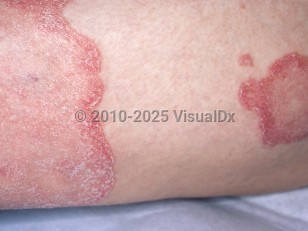Pustular psoriasis flares can be induced by infection (Trichophyton rubrum, cytomegalovirus, Streptococcus spp, varicella-zoster, and Epstein-Barr virus), a rapid withdrawal of corticosteroids, pregnancy, medications (NSAIDs, lithium, potassium iodine, trazodone, penicillin, interferon, and hydroxychloroquine), and topical irritants such as tar and anthralin. More recently, COVID-19 infection has been shown to trigger a pustular flare in a 12-year-old with prior plaque psoriasis in remission.
While tumor necrosis factor (TNF)-alpha antagonists such as infliximab and adalimumab are used to treat pustular psoriasis, they have also been reported paradoxically to induce it. Anti-IL-12/23 agents such as ustekinumab, anti-IL-23 agents, and anti-IL-17 agents induce significant improvement for some patients. Targeted therapy aimed at IL-36 (eg, spesolimab, which is approved for use in adults) has been demonstrated to rapidly improve pustular psoriasis regardless of IL36RN mutation status.
There are 3 subtypes of generalized pustular psoriasis:
- von Zumbusch type – Acute onset of generalized erythema and pustules with systemic manifestations including fever, skin tenderness, malaise, arthralgias, headache, and nausea. After several days, the pustules resolve to become confluent, scaling plaques.
- Exanthematic type – Acute onset of small pustules that are triggered by an infection or a drug. This subtype usually lacks systemic symptoms.
- Annular subtype – Erythematous, annular lesions that have pustules at the advancing edge of a lesion and is associated with fever, malaise, and other systemic manifestations.
Acrodermatitis continua of Hallopeau, in which the distal digits are primarily involved, is a localized form that rarely affects children.
Extracutaneous manifestations of pustular psoriasis may be severe and are associated with a great deal of morbidity and mortality. The most common extracutaneous manifestations of pustular psoriasis include cholestasis, cholangitis, arthritis, intestinal pneumonitis, oral lesions, and acute renal failure. Electrolyte disturbances such as hypocalcemia may occur and can be life-threatening. Lesions may also become superinfected.
Pustular psoriasis in children often has a more benign course than in adults, and children have a higher rate of spontaneous remission of generalized pustular psoriasis. Pediatric pustular psoriasis may be part of SAPHO syndrome (synovitis, acne, psoriasis / palmoplantar pustulosis, hyperostosis, osteitis).



